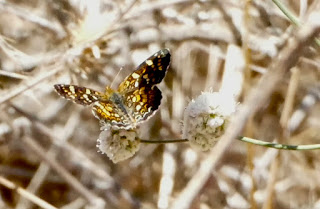Some have significant pieces of their wings missing.
Many sources say that the males are territorial: that the chases I saw were males claiming their patch of the hill. If so, how do they determine which one is the winner? How far away does the loser go? On the other hand, James Scott writes in The Butterflies of North America: A Natural History and Field Guide, "Although the male behavior of chasing passing objects looks pugnacious, males are not truly territorial but merely looking for females." If this is the case, I wonder what purpose the furious, spiraling flight serves. A test of fitness before a mate is accepted?
The larva are bristly black caterpillars with orange bumps. The bumps may serve as a warning to potential predators. One of the larvae's primary foods is the narrowleaf plantain. This plant has a molecule that inhibits growth in predators such as wasps, and and birds, though it increases growth in the caterpillars. Buckeye larvae that eat more plantain are less likely to be eaten by predators. Apparently, this protection does not extend to the adult butterflies, which are frequently eaten by birds. The missing chunks I noticed from their wings were probably from beak attacks.
In the bay area, buckeye butterflies can hatch at any time of year, but most hatch from mid-summer to early fall. They evolved from tropical species and cannot withstand severe cold no matter what life stage they are in. They were nearly wiped out in the bay area during an extremely cold week in 1990, then gradually recolonized our area. The appearance of the common buckeye vary depending on what time of year they hatch. Those born in winter or early spring are much smaller. Those born from late August through October have a purplish or brick-red underside, while those that hatch at other times are much paler. The genes controlling color in the buckeye are complex-- coding both for pigments as well as nanostructures that refract light and create iridescence. No one knows exactly how changing hours of daylight and temperature affect the expression of these genes.
As I watch the buckeyes, a speck of blue flickers on and off: the acmon blue has bright blue upper wings, but pale grey underwings. It is not much bigger than my thumb nail.
The field crescent has a similar color pallete as the buckeye, but in a stained-glass checkerboard.
At first glance, a grassy hillside in bay area summer appears fairly simple and monochromatic, but a world of color and complexity is revealed by the butterflies there. The orange bumps on a buckeye larvae hint at struggles and evolution among buckeyes, birds, ants, and plants: a contest at the scale of molecules. The changing shades of the buckeye wings mark the slow shift of the seasons, and hint at connections between the orbit of our planet and the genes in the butterflies' cells.
LINKS
Field Guide to Butterflies of the San Francisco Bay and Sacramento Valley Region (fabulous field guide and the source of much of the information in this post)
Art Shapiro's Butterfly Site (online butterfly guide from UC Davis)
Buckeye page
The Lawrence Hall of Science (butterfly habitat outside, science museum- and my desk- inside)
The Butterflies of North America: A Natural History and Field Guide




